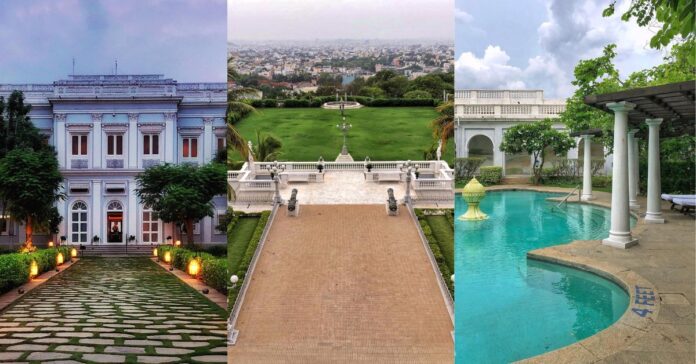Introduction:
Falaknuma Palace rises majestically amidst the Deccan hills, a testament to the glorious era of the Nizams. Often referred to as the “Taj of the Deccan,” this architectural marvel boasts a unique blend of Italian and Tudor architectural styles, adorned with opulent interiors and boasting a rich history.
This blog delves into the depths of Falaknuma Palace, exploring its origins, architectural brilliance, fascinating interiors, and its current avatar as a luxurious Taj Hotel.
The History of Falaknuma Palace:
The story of Falaknuma Palace begins with Nawab Vikar ul-Umra, the Prime Minister of Hyderabad during the reign of the Asaf Jah V (Pahadisha Nizam). Envisioned as a grand retreat, construction began in 1884 and spanned a decade. However, due to financial constraints, the Nawab couldn’t afford to complete the palace.
In 1897, the opulent palace caught the eye of the sixth Nizam, Mir Mahbub Ali Khan, who acquired it and commissioned further construction. The Nizam envisioned Falaknuma Palace as a guesthouse for visiting dignitaries and a symbol of the Nizam’s affluence.
Also Read: A Journey Through Time: Top 10 Heritage Buildings in Hyderabad
Renowned architect Sir Caspar Jeevar was entrusted to complete the palace. Jeevar meticulously incorporated Italian marble, Belgian cut glass, and exquisite furniture, transforming Falaknuma into a haven of luxury.
The palace remained a royal guesthouse until the last Nizam, Osman Ali Khan, passed away in 1967. Later, the palace was acquired by the Taj Hotel Group in 1984 and meticulously restored to its former glory. Today, Falaknuma Palace stands as a luxurious hotel, offering guests a glimpse into the opulent lifestyle of the Nizams.
An Architectural Masterpiece: A Blend of Styles
Falaknuma Palace is a visual tapestry woven from diverse architectural influences. The external facade showcases a predominantly Italianate style, with symmetrical proportions, a central portico, and grand arches. Mughal influences are evident in the use of cupolas, minarets, and the central dome, adding a touch of grandeur. Hints of Tudor style can be seen in the half-timbered sections and ornamental chimneys.
The amalgamation of these styles creates a unique and awe-inspiring architectural marvel. As you ascend the grand staircase, adorned with Venetian chandeliers and Persian carpets, the architectural grandeur becomes even more apparent.
A Dazzling Display: The Opulent Interiors of Falaknuma Palace
Step inside Falaknuma Palace, and be prepared to be transported to a bygone era of opulence. The interiors are a dazzling display of exquisite craftsmanship and a testament to Nizam’s penchant for luxury.
The Durbar Hall:
This magnificent hall, adorned with intricately carved Belgian cut glass chandeliers, Italian marble flooring, and ornate stucco work, was used for hosting royal audiences and grand receptions.
The Library:
Falaknuma Palace boasts a magnificent library housing over 6,200 rare manuscripts, including the Holy Quran inscribed on a single grain of rice. The library’s interiors are adorned with rich wood paneling and stained glass windows, creating an atmosphere of scholarly serenity.
The Dining Hall:
Fit for royalty, the dining hall features a long mahogany table that can seat 101 guests. The exquisite crockery and cutlery used by the Nizams are on display, offering a glimpse into the grandeur of royal dining.
The Billiard Room:
This room is a haven for game enthusiasts, featuring a beautifully crafted billiards table and plush armchairs. The intricate ceiling work and ornately framed paintings add to the room’s charm.
The Guest Chambers:
Each guest chamber in Falaknuma Palace is a masterpiece in itself. The rooms are adorned with rich fabrics, plush carpets, and antique furniture, offering guests a luxurious and comfortable stay.
Also Read: Ultimate Guide to Adventure Places in Hyderabad: A Three-Day Itinerary
Every corner of Falaknuma Palace reflects the Nizam’s love for the finer things in life. The use of rich materials, intricate craftsmanship, and exquisite artwork create an ambiance of unparalleled luxury and grandeur.
A Luxurious Legacy: Falaknuma Palace as a Taj Hotel
Today, Falaknuma Palace operates as a luxurious Taj Hotel, offering guests a unique opportunity to experience the royal lifestyle.
Luxuriate in Opulent Accommodations: The hotel offers a variety of rooms and suites, each meticulously restored to reflect the palace’s grandeur.
- Indulge in Culinary Delights: The hotel’s restaurants offer a variety of cuisines, including Hyderabad Foods and international fare.
A Luxurious Legacy: Falaknuma Palace as a Taj Hotel
Explore the Palace’s Grandeur: The hotel offers guided tours of the palace, allowing guests to delve into its history and architectural marvels.
Experience Royal Traditions: Guests can enjoy horse-drawn carriage rides through the palace grounds, a delightful echo of the bygone era.
Relax and Rejuvenate: The hotel features a luxurious spa offering a variety of treatments for ultimate relaxation.
Host Unforgettable Events: Falaknuma Palace provides a stunning backdrop for weddings, conferences, and other special occasions.
Staying at Falaknuma Palace is more than just a luxurious stay; it’s an immersive experience into the heart of Hyderabad’s royal heritage.
Also Read: Hyderabad Chowmahalla Palace: A Journey of the History
A Timeless Legacy: A Visit to Falaknuma Palace
Whether you choose to stay at the Taj Falaknuma Palace or simply visit for a day trip, the palace offers a unique and unforgettable experience. Here are some additional things to keep in mind when planning your visit:
Timings and Falaknuma Palace Entry Fee:
Falaknuma Palace, is open to the public for tours on specific days and times. It’s advisable to check the official Taj Falaknuma Palace the hotel for current timings and Falaknuma Palace entry fees.
How to Reach Falaknuma Palace:
The palace is located approximately 5 kilometers from Charminar. Taxis, autos, and cabs are readily available for hire.
Dress Code:
While there’s no strict dress code, modest attire is recommended, especially if you plan to explore the palace interiors.
Photography:
Photography is allowed within the palace premises, but flash photography might be restricted in certain areas.
Falaknuma Palace Reviews:
generally rave about the opulent interiors, exceptional service, and the unique opportunity to experience a bygone era. However, some reviews mention the high cost of staying at the palace.
A visit to Falaknuma Palace, is a journey through time, transporting you to the era of the Nizams. It’s a place where history whispers from the ornate walls, and grandeur resonates in every corner. So, pack your bags (or book your stay!), and embark on an unforgettable journey to this architectural marvel in the heart of Hyderabad.
Conclusion
Falaknuma Palace stands as a magnificent testament to the grandeur and opulence of the Nizam era, blending Italian, Tudor, and Mughal architectural styles into a unique and awe-inspiring masterpiece. From its origins as the vision of Nawab Vikar ul-Umra to its transformation under the Nizam’s patronage and eventual rebirth as a luxurious Taj Hotel, the palace encapsulates a rich tapestry of history, culture, and luxury.
Frequently Asked Questions:
Originally built by a Prime Minister in the 1880s, Falaknuma Palace was later acquired by the Nizam of Hyderabad. Today, it operates as a luxurious Taj Hotel.
A visit to Falaknuma Palace offers a variety of experiences. Guests can embark on guided tours to delve into the palace’s history, take a nostalgic ride in a horse-drawn carriage, or unwind with pampering treatments at the luxurious spa.
Yes! The Taj Falaknuma Palace offers guests a chance to experience royal luxury. Choose from opulent rooms and suites, indulge in world-class dining featuring Hyderabadi delicacies and international fare, and create unforgettable memories.
Falaknuma Palace boasts a unique blend of architectural influences. The facade features a predominantly Italianate style, while Mughal elements are evident in the domes and minarets. Hints of Tudor style can also be seen throughout the palace.
Step inside Falaknuma Palace and be prepared to be dazzled. The opulent interiors feature exquisite craftsmanship and a collection of treasures











